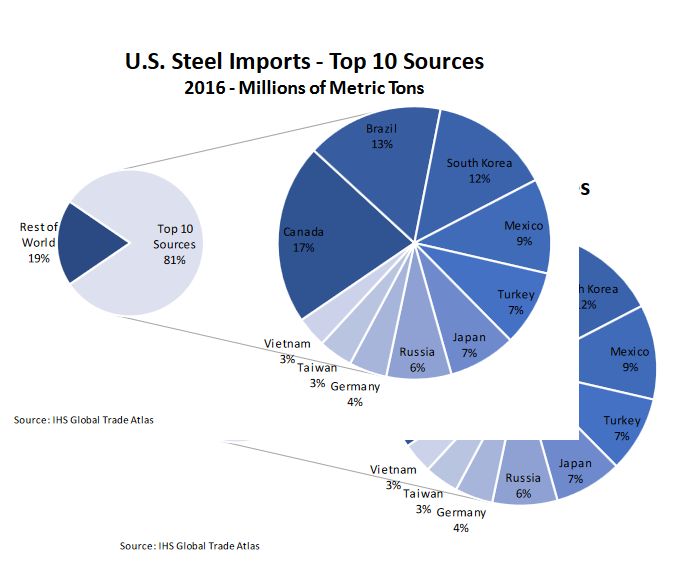US Commerce Secretary Ross promised to conclude the special investigation into US steel imports in the name of US national security by the end of the month. The outcome of the investigation is largely a foregone conclusion. Even before the investigation began, Ross said he would need less than a third of the allowable time.
The real issue is how will the US steel industry be protected by the Trump Administration. It is already a highly protected sector and the price of steel is higher in the US as compared to world prices. There are two general approaches. The first is a board tariff on all imports. The second is a combination of a quota and a tariff on imports about the threshold. The former is recognized as a tougher than the latter, with more collateral damage.
Judging from the rhetoric, China is the significant target. However, China accounts for around 2% of US steel imports and these imports have fallen for two years. Part of the reason for the decline in steel imports from China is that it has been subject to around 200 anti-dumping and countervailing measures that remain in place. More broadly, US steel imports have fallen for two years. Last year the US imported 30.1 mln metric tons, down from a near-record in 2014 of 40.3 mln metric tons. Steel imports account for around 1% of total US goods imports.
The US International Trade Commission report on global steel trade showed this graphic of the top suppliers to the US market. Note that the US imports steel from 110 countries and territories. It shows that Canada, Brazil, South Korea, Mexico and Turkey are the top five providers of steel into the US. Imports from Vietnam surged (190%) in 2016, and there are some suspicions that this is a direct or indirect result of China.

There are domestic and international implications of more protection for the steel industry. The protection is for steel producers, so the cost of the protection will be shouldered by consumers. The value-added by the US steel industry is about 0.2% of GDP or about $36 bln. The value-added by companies that use steel as an input (think autos, construction, appliances) account for roughly 5.8% of GDP or a little more than $1 trillion.
The quota coupled with a tariff on exports about the quota is seen as having less impact than across the board tariff. However, we need to be careful in distinguishing a relative price increase from a general increase in prices. The latter is inflationary, but the former is not. A higher relative price of steel may encourage substitution, for example, and the use of wood, non-steel alloys, and other materials.
Internationally, either action by the US administration will be controversial. Claiming national security interest is also seen as raising the stakes. Although only Germany is the top-10 providers of steel to the US, several eurozone countries, including Italy, Spain, Belgium and Latvia export steel to the US. The EU has threatened to challenge the US at the WTO should any of its members be subject to the tariff.
Even if the US case has merits, many US allies wish that the US would go through the multilateral process created by the WTO. The US has an impressive track record at winning case its take to the WTO. The WTO is not just about the rules of trade, but it also provides a conflict resolution mechanism.
The imposition of a new round of protectionism by the US and a likely WTO challenge will create a dangerous dilemma that will test the resilience of the international trade regime. If the WTO rules against the US, the Trump Administration may choose to ignore the ruling, as it has threatened to do. This would challenge the institutional authority of the WTO and put the multilateral system, which the US helped build at risk.
Alternatively, the WTO rules in the US favor, respecting the executive judgment of what constitutes a national security. This would likely spur other countries to mimic the US defense and spur a new form of protectionism and a retreat from free-trade ideals and practices. The WTO's national security exemption has not been explored, and this could be a significant opportunity.
US President Trump's agenda has been frustrated in its first several months. The judiciary has blocked much of the travel ban that was proposed. Congress, despite Republican majorities in both chambers, has not done the President's bidding. The supplemental budget for the current fiscal year looks a lot more like Obama's than Trump's proposals. When the healthcare bill passed the House, the President seemed to endorse it, but now, as the CBO scoring is awaited, he seems to prefer the Senate version, which may not get the 51 votes it needs to pass this week.
The one area in which the president has a freer hand is with executive orders. Citing a rarely used 1962 trade law, Trump will have a great deal of discretion that cannot be challenged by Congress (though it can claw back the power, this seems highly unlikely). That Trump may feel frustrated by encouraging him to be exceptionally forceful in the areas in which he can, like trade.
It is possible that some countries are exempt from the US actions. Some suggest that Canada and Mexico can get a waiver, even though they are the largest and fourth largest foreign providers of steel to the US. NAFTA renegotiations are slated to begin in August and steel will likely be discussed. Some NATO members have been pressing the Pentagon to intercede on their behalf, but given Trump's criticism of NATO and Germany's trade practices, this seems unlikely. This will make for an awkward G20 summit next month.
